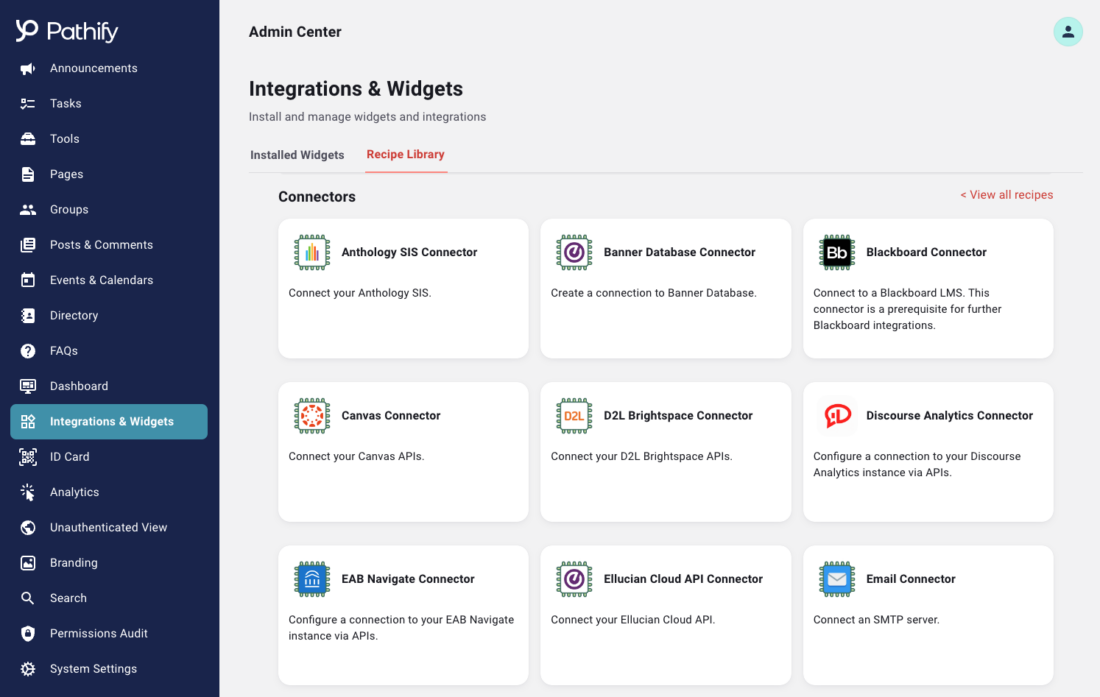It’s no secret Jeff Ledoux’s experience on the Web Applications team at Johnson & Wales University makes him a phenomenal Product Manager at Pathify. With a background in supporting digital initiatives — including a student portal, mobile app and internal websites — Jeff saw the value of customer collaboration first-hand before joining Pathify.
Now heading up the Product team, Jeff pushes Pathify’s roadmap forward. With meticulous attention to customer feedback and suggestions, his team ensures new product releases and updates align with the genuine needs of the Pathify user community. The Recipe Library represents one of these avenues – step-by-step, pre-built integrations launching within minutes, with no developers necessary. The Recipe Library releases valuable time back to IT/development teams and empowers students with personalized information, facilitating a more connected and engaging experience.
In our Q&A, Jeff breaks down the importance of no-code integrations, explores the nuts and bolts of developing new recipes, and shares how the Recipe Library’s future will supercharge the student experience.
This marks the final installment in our three-part series, accompanying blog posts around the inner workings of Product Development and Flow.
This interview transcript has been edited for clarity and brevity.
Pathify: What inspired the development of the Recipe Library?
Jeff Ledoux: The Recipe Library was well in the works before I joined Pathify in early 2023. When I heard about it as a customer, I got excited for reasons at the core of why the Recipe Library exists today. For starters, reducing the amount of custom work frees teams up for other projects. It’s vital because there’s a never-ending backlog of things to do in higher ed IT. It also allows customers to quickly and easily maintain the “single pane of glass” approach with their portal — surfacing valuable and actionable data to appropriate audiences is crucial in providing a great experience.
Pathify: How does the Recipe Library align with Pathify’s vision of improving the student experience?
JL: As a previous customer, I always had requests for integrations, the “It’d be great if we could see X thing,” type of requests. With the Recipe Library — and the cadence at which we’re delivering new Recipes — you can now check if X thing is available, run it, and make it visible to your audience. UI/UX fatigue is real and bouncing users from one system to another isn’t only frustrating but stressful and exhausting. The Recipe Library closes the gap by allowing teams to surface more data to constituents, reducing the number of systems they log into to fulfill a task or view information.
Pathify: Can you speak to the user-friendliness of the Recipe Library?
JL: The Recipe Library requires no coding expertise, making it great for portal admins who may not possess a technical background. There is some level of data collection needed before kicking off some recipes — you might need to involve your IT or systems team to gather the information you need — but that’s the general extent of it. We want to make the Library as user-friendly as possible and we’re committed to making it even easier to use and understand in 2024.

Pathify: What’s the development process for creating new Recipes?
JL: We pay close attention to a few channels when planning new Recipes — for example, partner conversations, Canny requests, and even where we stand within the higher ed calendar. Once we’ve decided on building a new Recipe, we go through our design process. Simultaneously, we’re establishing customer champions verifying what we’re building aligns with what they envision. We’re also securely testing live data which increases the time to success. If we’ve done our job correctly, we won’t run into major changes after releasing the first version of a Recipe.
Then it’s off to Engineering to get built — those teams do real magic to get Recipes into the hands of our customers. It’s pretty incredible to watch.
From there, we love to iterate and bring new functionality to Recipes. LMS Recipes are a good example — from where they started to where they are now is drastically different and much improved but it’s all for the best.
Pathify: Can you share what it’s like managing the feedback going into creating new Recipes?
JL: It’s both challenging and exciting when deploying a new Recipe. I love it when a customer goes “This new Recipe is great but can you add one thing?” It’s one of those lightbulb moments for us and we typically get feedback scheduled for an upcoming sprint. It’s a lot of fun to turn those requests around quickly and continue adding value to Recipes as we go. It’s nearly impossible to speak with our 100+ customers about every planned Recipe — providing feedback in Canny is so important because we can share what’s coming next.
Pathify: How do you ensure the Recipe Library remains flexible and relevant to institutions’ evolving needs?
JL: I always want to make sure Recipes are flexible enough for customers to use right out of the gate. We work in higher ed and there are many ways to accomplish one thing. We address flexibility with Flow — if you’re a Flow customer, you can kick off a Recipe and then make changes to it based on the needs of your institution.
With every Recipe, we aim to strike the right balance of surfacing data in ways that suit the audience who needs it, while not going too far down the rabbit hole for the needs of one singular institution. The Recipe Library provides great flexibility and out-of-the-box integrations, with our team available for additional, custom integration work.
Pathify: What excites you most about the impact the Recipe Library makes on the future of digital experiences in higher education?
JL: I’m looking forward to what we’re doing this year with the Recipe Library. Right now, most Recipes are one-way and we’re exploring two-way Recipes in 2024. This means users won’t navigate across separate systems to take action from something surfaced in the Portal. Instead, they’ll complete items directly inside the Engagement Hub. This will really move us towards a true one-stop shop, no matter what audience you’re serving. Don’t get me wrong — surfacing information is still incredibly important — but the ability to act without going anywhere else pushes the needle forward in a massive way.
Customer Story: Creating Custom Widgets
Centered around the philosophy of providing better student experiences, both John Brown University’s and Concordia University Irvine’s custom widgets facilitated portal adoption, streamlined course management, and highlighted critical campus tools, news and events. With the help of Pathify’s Product team, the institutions launched custom widgets supporting creative endeavors like dining hall menus, printing solutions, athletics, school newspaper feeds and more.
“Having very specific widgets definitely improves the experience,” said Ryan Jones, Director of Data Integration Services at Concordia University Irvine.
“Pathify’s ability to have a link that goes to an iFrame of whatever we want to surface on our end has been huge,” added Jonathan Dennis, John Brown University’s Director of Application Services. “Having the flexibility to give certain information or targeted information to students is very beneficial.”
Learn more about how each institution leveraged custom widgets.
